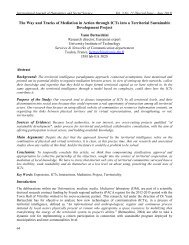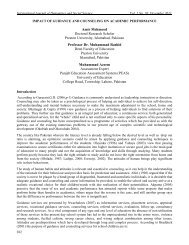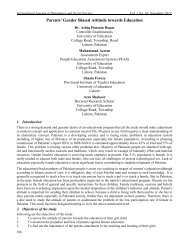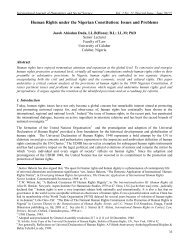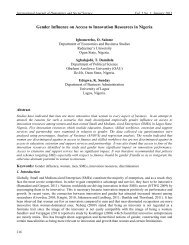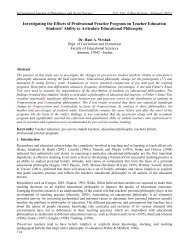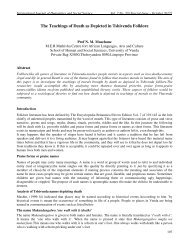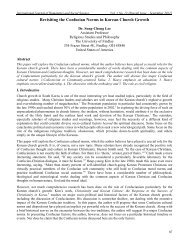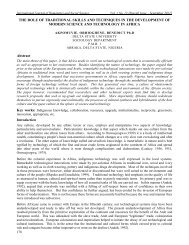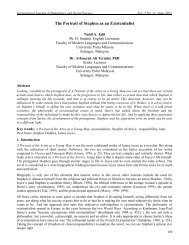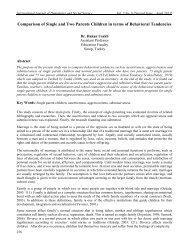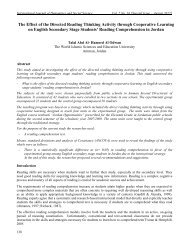Role of Talent Management on Organızatıon Performance in ...
Role of Talent Management on Organızatıon Performance in ...
Role of Talent Management on Organızatıon Performance in ...
You also want an ePaper? Increase the reach of your titles
YUMPU automatically turns print PDFs into web optimized ePapers that Google loves.
The Special Issue <strong>on</strong> Social Science Research © Center for Promot<strong>in</strong>g Ideas, USA www.ijhssnet.com<br />
The talent pool is a group <str<strong>on</strong>g>of</str<strong>on</strong>g> employees with special traits and are source <str<strong>on</strong>g>of</str<strong>on</strong>g> future senior executives(Ballesteros et<br />
al ,2010).The sources <str<strong>on</strong>g>of</str<strong>on</strong>g> talented employees can be <strong>in</strong>ternal or external .The best way to create a talent pool is the<br />
<strong>in</strong>ternal sources s<strong>in</strong>ce the employees have already the knowledge <str<strong>on</strong>g>of</str<strong>on</strong>g> how bus<strong>in</strong>ess processes work and can be<br />
<strong>in</strong>corporated directly <strong>in</strong>to the new positi<strong>on</strong> and the morale <str<strong>on</strong>g>of</str<strong>on</strong>g> workforce uplifted (David et al 2007).However, if<br />
the organizati<strong>on</strong> want to <strong>in</strong>troduce radical changes or to renew the culture ,external sources are the best<br />
(Ballesteros et al ,2010). Employer brand<strong>in</strong>g <strong>in</strong>cludes development <str<strong>on</strong>g>of</str<strong>on</strong>g> an organizati<strong>on</strong>’s image, good enough to<br />
attract employees. In order to attract the best, organizati<strong>on</strong>al brand<strong>in</strong>g is a useful strategy, the organizati<strong>on</strong>s that<br />
manages its corporate brands effectively, ga<strong>in</strong>s advantage <strong>in</strong> the highly competitive global market place .Without<br />
the good brand image, it is difficult to attract the right talents (Ana, 2009).Top rated companies have <strong>on</strong>e<br />
characteristic <strong>in</strong> comm<strong>on</strong> ,that is they give clear and c<strong>on</strong>sistent messages about themselves and that translates <strong>in</strong>to<br />
a str<strong>on</strong>g pull <strong>on</strong> talents (Tanuja, 2007). Employee value propositi<strong>on</strong> is characterized by the potential employee’s<br />
percepti<strong>on</strong> <str<strong>on</strong>g>of</str<strong>on</strong>g> the value <str<strong>on</strong>g>of</str<strong>on</strong>g> an organizati<strong>on</strong> seek<strong>in</strong>g to recruit him. The employee measure value propositi<strong>on</strong> based<br />
<strong>on</strong> the challenge the job posses, work envir<strong>on</strong>ment, tra<strong>in</strong><strong>in</strong>g opportunities, flexibility and reputati<strong>on</strong> <str<strong>on</strong>g>of</str<strong>on</strong>g> the<br />
organizati<strong>on</strong> (Oehley, 2007).<br />
2.2 <str<strong>on</strong>g>Talent</str<strong>on</strong>g> Retenti<strong>on</strong><br />
<str<strong>on</strong>g>Talent</str<strong>on</strong>g> retenti<strong>on</strong> aims to take measures to encourage employees to rema<strong>in</strong> <strong>in</strong> the organizati<strong>on</strong> for the maximum<br />
period <str<strong>on</strong>g>of</str<strong>on</strong>g> time. <str<strong>on</strong>g>Talent</str<strong>on</strong>g> turnover is harmful to a company's productivity because costs <str<strong>on</strong>g>of</str<strong>on</strong>g> attracti<strong>on</strong> are high. Direct<br />
cost refers to turnover costs, replacement costs and transiti<strong>on</strong>s costs, and <strong>in</strong>direct costs relate to the loss <str<strong>on</strong>g>of</str<strong>on</strong>g><br />
producti<strong>on</strong>, reduced performance levels, unnecessary overtime and low morale ( Echols, 2007) .Vaiman et al<br />
(2008) def<strong>in</strong>e two classificati<strong>on</strong>s <str<strong>on</strong>g>of</str<strong>on</strong>g> retenti<strong>on</strong> tool to suffice employee’s expectati<strong>on</strong>: extr<strong>in</strong>sic and <strong>in</strong>tr<strong>in</strong>sic<br />
<strong>in</strong>centives. Extr<strong>in</strong>sic <strong>in</strong>centives <strong>in</strong>cludes different sorts <str<strong>on</strong>g>of</str<strong>on</strong>g> m<strong>on</strong>etary rewards which can satisfy employees‘<br />
physiological needs, while <strong>in</strong>tr<strong>in</strong>sic <strong>in</strong>centives refer to n<strong>on</strong>-m<strong>on</strong>etary rewards that can fulfil employees‘<br />
psychological needs. The m<strong>on</strong>etary reward is admitted as an essential tool to reta<strong>in</strong><strong>in</strong>g talent (Vaiman et al, 2008).<br />
Mendez et al, (2011) further emphasizes that a company needs to <strong>in</strong>vest <strong>in</strong> employee retenti<strong>on</strong> <strong>in</strong> order to be<br />
successful. For example, a good compensati<strong>on</strong> package is important <strong>in</strong> reta<strong>in</strong><strong>in</strong>g employees, <str<strong>on</strong>g>of</str<strong>on</strong>g>fer<strong>in</strong>g an attractive,<br />
competitive benefits package with comp<strong>on</strong>ents such as life <strong>in</strong>surance, disability <strong>in</strong>surance and flexible hours<br />
motivates employees to commit themselves to an organizati<strong>on</strong> (Lockwood et al, 2006). In light <str<strong>on</strong>g>of</str<strong>on</strong>g> the above, a<br />
salary <str<strong>on</strong>g>of</str<strong>on</strong>g>fered to an employee should not <strong>on</strong>ly be viewed as a sum <str<strong>on</strong>g>of</str<strong>on</strong>g> m<strong>on</strong>ey, but as a package <str<strong>on</strong>g>of</str<strong>on</strong>g> remunerati<strong>on</strong> <strong>in</strong><br />
order for the payment to serve as a retenti<strong>on</strong> factor. Gomez-Mejia et al (2006) refers to this as <strong>in</strong>ternal and<br />
external equity. External equity is the perceived fairness <str<strong>on</strong>g>of</str<strong>on</strong>g> the remunerati<strong>on</strong> <strong>in</strong> comparis<strong>on</strong> to how much other<br />
employees <strong>in</strong> the same k<strong>in</strong>d <str<strong>on</strong>g>of</str<strong>on</strong>g> work are receiv<strong>in</strong>g <strong>in</strong> the same <strong>in</strong>dustry. On the other hand, <strong>in</strong>ternal equity refers<br />
to how an employee perceives his pay to be fair <strong>in</strong> comparis<strong>on</strong> to another employee who he perceives to be <strong>in</strong> a<br />
similar positi<strong>on</strong> with<strong>in</strong> the same organizati<strong>on</strong>.<br />
2.3 Learn<strong>in</strong>g and Development<br />
<str<strong>on</strong>g>Talent</str<strong>on</strong>g> development is the process <str<strong>on</strong>g>of</str<strong>on</strong>g> chang<strong>in</strong>g an organizati<strong>on</strong>, its employees, its stakeholders, and groups <str<strong>on</strong>g>of</str<strong>on</strong>g><br />
people with<strong>in</strong> it, us<strong>in</strong>g planned and unplanned learn<strong>in</strong>g, <strong>in</strong> order to achieve and ma<strong>in</strong>ta<strong>in</strong> a competitive advantage<br />
for the organizati<strong>on</strong> (Davis et al, 2007). As bus<strong>in</strong>esses c<strong>on</strong>t<strong>in</strong>ually apply new technologies, new bus<strong>in</strong>ess growth<br />
models, and new market strategies, the workforce‘s up-skill<strong>in</strong>g becomes c<strong>on</strong>stant and c<strong>on</strong>t<strong>in</strong>uous. Understand<strong>in</strong>g<br />
strategies to talent retenti<strong>on</strong> and development will be able to help companies listed <strong>in</strong> the Nairobi Security<br />
Exchange to be successful <strong>in</strong> operat<strong>in</strong>g <strong>in</strong> the market place hence lead to good organizati<strong>on</strong> performance.<br />
Organizati<strong>on</strong>s which practice effective learn<strong>in</strong>g and development beg<strong>in</strong> with their employees. This implies that<br />
they identify the employees who need learn<strong>in</strong>g and development, the level <str<strong>on</strong>g>of</str<strong>on</strong>g> learn<strong>in</strong>g and development they need<br />
and the durati<strong>on</strong> dur<strong>in</strong>g which learn<strong>in</strong>g takes place (Harburg, 2003).organizati<strong>on</strong>s with first class learn<strong>in</strong>g and<br />
development <strong>in</strong>itiatives are excellent <strong>in</strong> listen<strong>in</strong>g <strong>on</strong> employee improvement needs and are able to express those<br />
needs back to the employee <strong>in</strong> clear and enlighten<strong>in</strong>g terms.<br />
CIPD (2010) study <strong>on</strong> learn<strong>in</strong>g and talent development results <strong>in</strong>dicated that <strong>in</strong>-house development programmes<br />
at 56%and coach<strong>in</strong>g by l<strong>in</strong>e managers at 51% ranked am<strong>on</strong>g the top effective learn<strong>in</strong>g and development practices.<br />
E-learn<strong>in</strong>g was also identified as key <strong>in</strong> learn<strong>in</strong>g and development. Moreover, the study found that senior<br />
managers and the human resource department were tasked with ensur<strong>in</strong>g that courses were delivered and overall<br />
plann<strong>in</strong>g <str<strong>on</strong>g>of</str<strong>on</strong>g> the learn<strong>in</strong>g process carried out effectively. This study was carried out through a survey <str<strong>on</strong>g>of</str<strong>on</strong>g> various<br />
organizati<strong>on</strong>s.<br />
286



